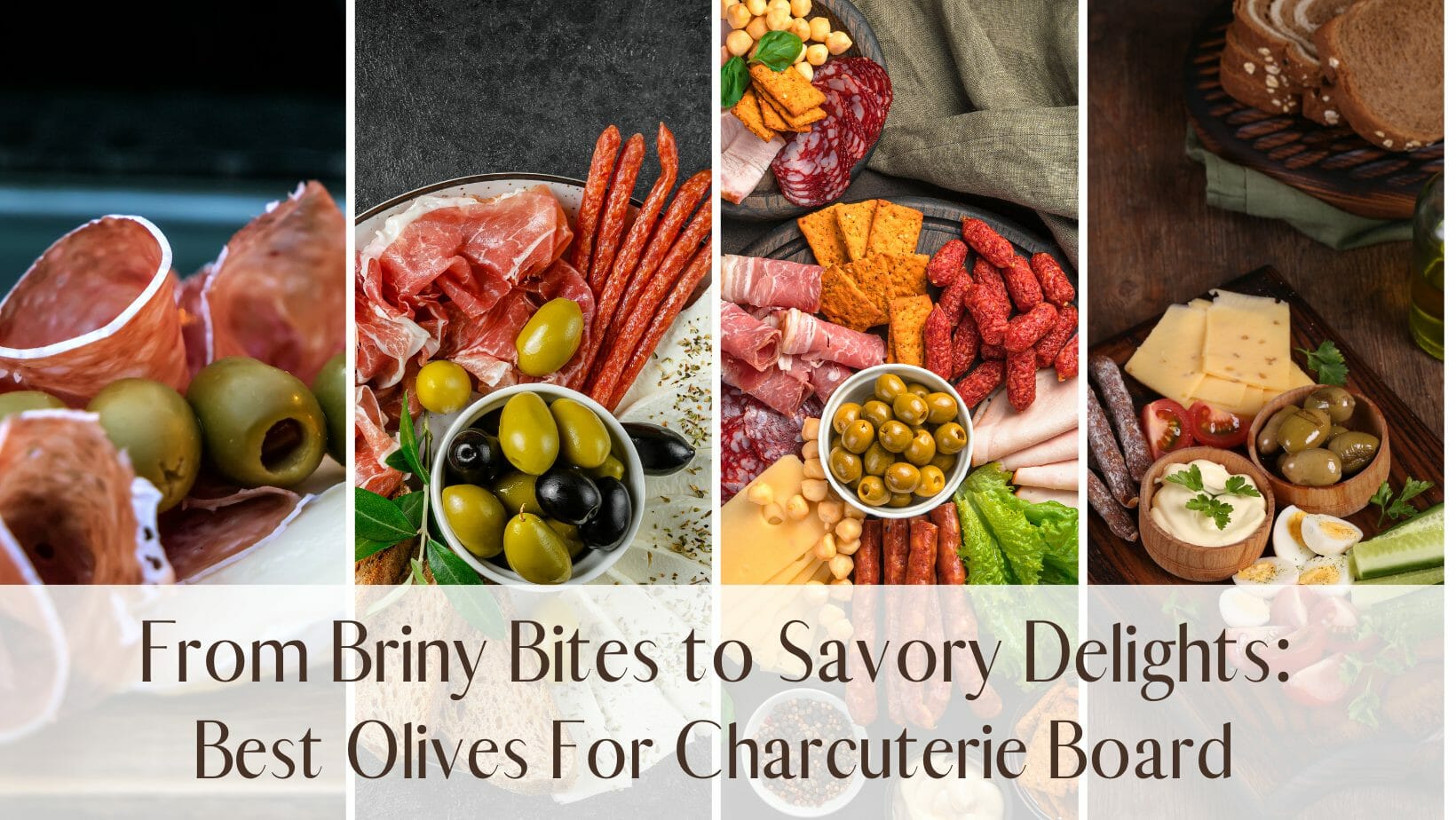Welcome to the world of exquisite charcuterie boards! Embark on a culinary journey as we unravel the secrets of selecting the finest olives to elevate your spread. From the bold flavors of green and black olives to the Mediterranean charm of Kalamata and the buttery allure of Castelvetrano, we'll guide you through pairing suggestions, presentation techniques, and even explore the health benefits. Get ready to create a charcuterie board that tantalizes the taste buds and leaves your guests craving for more. Let's dive into the art of choosing olives for a charcuterie board like a true connoisseur.
TIP: Fast-track your charcuterie skills and connect with 514K experts. Click for instant access to our comprehensive guide and community >>
Table of Contents [CLICK HERE TO OPEN]
Briny Delights
At the heart of every unforgettable charcuterie board lies a secret ingredient that brings a delightful twist to the ensemble: olives. Yes, those small, versatile orbs of goodness have claimed their rightful place among the stars of the charcuterie show.
Picture a vibrant array of cured meats, artisanal cheeses, crusty bread, and an assortment of delectable accompaniments. Amidst this cornucopia of flavors, olives stand tall, offering their briny, savory allure. Their presence on a charcuterie board adds a burst of Mediterranean charm, a touch of sophistication, and an explosion of taste that captivates the senses.
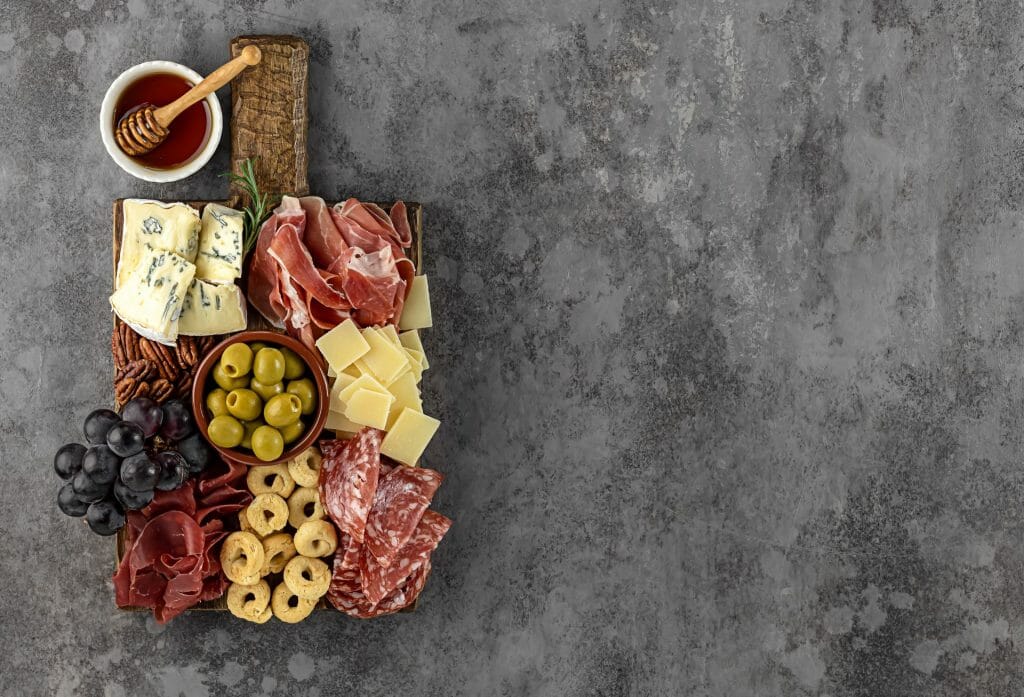
Why are olives the perfect companions for your charcuterie board adventure?
Well, let's start with their incredible versatility. Olives come in a variety of types, each boasting its own distinct flavor profile. From the tangy and slightly bitter green olives to the milder and meatier black olives, there's a delightful range to explore. And let's not forget the renowned Kalamata olives with their rich, briny taste, or the buttery and sweet Castelvetrano olives that melt in your mouth. The possibilities are endless.
But it's not just about the taste. Olives bring a sense of depth and balance to the charcuterie board. They serve as a palate cleanser, cutting through the richness of the meats and cheeses, providing a refreshing and satisfying contrast. As you indulge in a succulent piece of cured meat, a bite of creamy cheese, or a dollop of tangy spread, the olive acts as a flavorful bridge, connecting the dots and enhancing the overall gastronomic experience.
In recent years, the charcuterie board trend has skyrocketed, with social media platforms brimming with mouthwatering photos and endless inspiration. But here's the thing: not all olives are created equal, and selecting the right ones for your charcuterie board can make all the difference. That's why it's crucial to embark on this olive journey with confidence and knowledge, armed with the understanding of which olives will take your charcuterie board from ordinary to extraordinary.
So, whether you're a seasoned charcuterie enthusiast or just starting to explore the wonders of this culinary art form, join us as we delve into the world of olives for charcuterie boards. Get ready to unlock the secrets, discover the perfect pairings, and elevate your charcuterie board to new heights of deliciousness. It's time to awaken your taste buds and embark on a tantalizing adventure through the realm of olives for charcuterie boards.
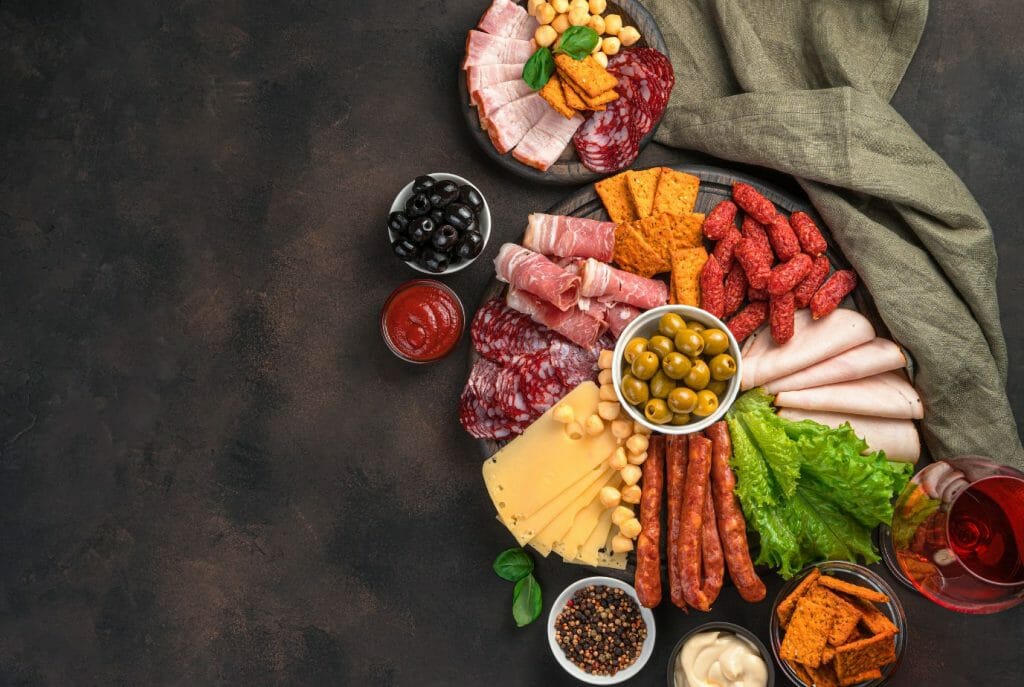
Types of Olives for Charcuterie Boards
Green Olives for Charcuterie Board
When it comes to vibrant pops of flavor on your charcuterie board, green olives take center stage. These little powerhouses are known for their tangy and slightly bitter taste, adding a zesty kick to your ensemble. With their firm texture and vibrant hues, they not only tantalize the taste buds but also provide a visual feast.
Green olives are a popular choice for charcuterie boards due to their versatility and ability to complement a wide range of flavors. They pair exceptionally well with cured meats like prosciutto or salami, as the saltiness of the meat beautifully balances the olive's tanginess. For a burst of freshness, consider combining green olives with crisp vegetables like cucumber slices or bell pepper strips.
To serve green olives on your charcuterie board, you can showcase their unique flavors by marinating them in a blend of herbs, garlic, and olive oil. This infusion adds an extra layer of complexity, elevating the olives to new heights. Alternatively, you can opt for stuffed green olives filled with ingredients like feta cheese, almonds, or even fiery chili.
Don't be afraid to experiment with different flavor pairings to discover your personal favorite. For a Mediterranean-inspired twist, try combining green olives with sundried tomatoes, feta cheese, and a drizzle of balsamic glaze. The interplay of flavors will transport you to the sunny shores of the Mediterranean, tantalizing your taste buds with each delightful bite.
Remember, the key to a memorable charcuterie board is balance and variety. Incorporating green olives adds a lively and tangy element to counterbalance the richness of other ingredients. With their distinct flavor profile, green olives bring a touch of excitement to your charcuterie board, ensuring a dynamic and unforgettable gastronomic experience.
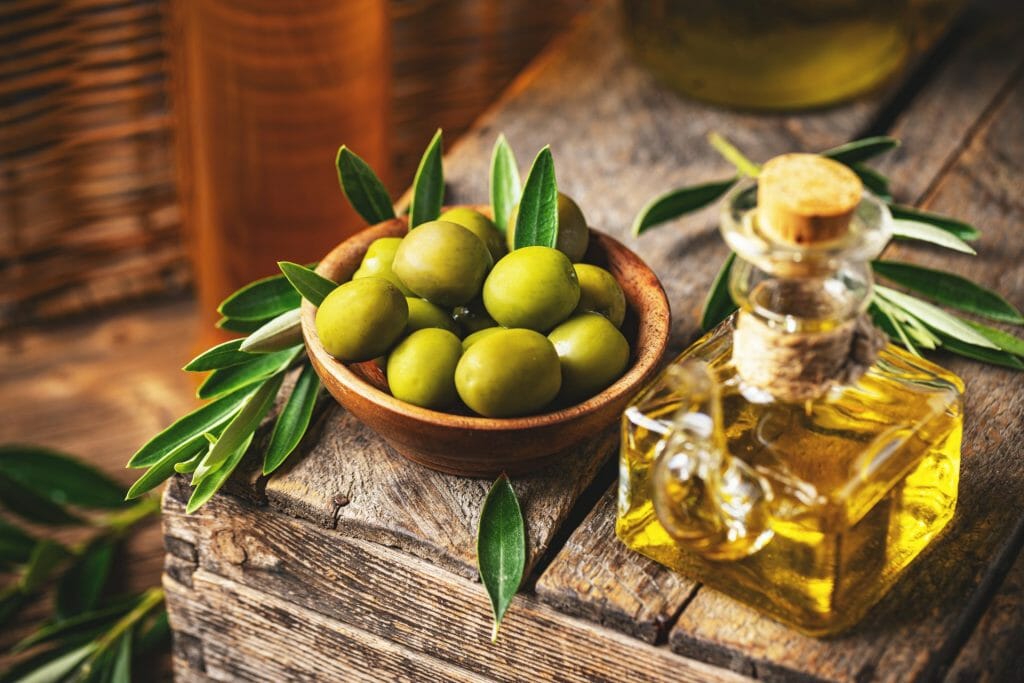
Black Olives for Charcuterie Board
Amidst the vibrant medley of flavors on a charcuterie board, black olives make a striking appearance, bringing their own distinct allure to the table. With their rich and meaty flavor, these olives add depth and complexity to your culinary masterpiece.
Black olives come in various varieties, each with its own unique characteristics. The popular Kalamata olives, hailing from Greece, are renowned for their rich, briny taste and firm texture. They bring a touch of authenticity to your charcuterie board, transporting your palate to the sun-drenched shores of the Mediterranean.
Another notable black olive variety is the Niçoise olive, originating from the French Riviera. These small, jet-black olives offer a mild and slightly fruity flavor with a hint of bitterness. They add an elegant touch to your charcuterie board, providing a subtle yet distinctive taste that pairs harmoniously with a variety of ingredients.
When incorporating black olives into your charcuterie board, consider their pairing options. These olives beautifully complement cured meats such as Spanish chorizo or Italian capicola, enhancing the savory experience. For a delightful balance, pair them with creamy cheeses like goat cheese or Camembert, allowing the contrasting textures and flavors to create a symphony on your taste buds.
To showcase the true essence of black olives, serve them in their natural state, simply pitted and brimming with flavor. Their striking color adds visual appeal to the board, enticing your guests to indulge in their savory goodness. You can also experiment with marinated black olives, infusing them with herbs, garlic, or citrus zest to elevate their taste to new heights.
Remember, the beauty of a charcuterie board lies in the diversity of flavors and textures. By incorporating black olives, you introduce a nuanced and robust element to the ensemble, captivating the senses and adding a touch of sophistication to your culinary creation.
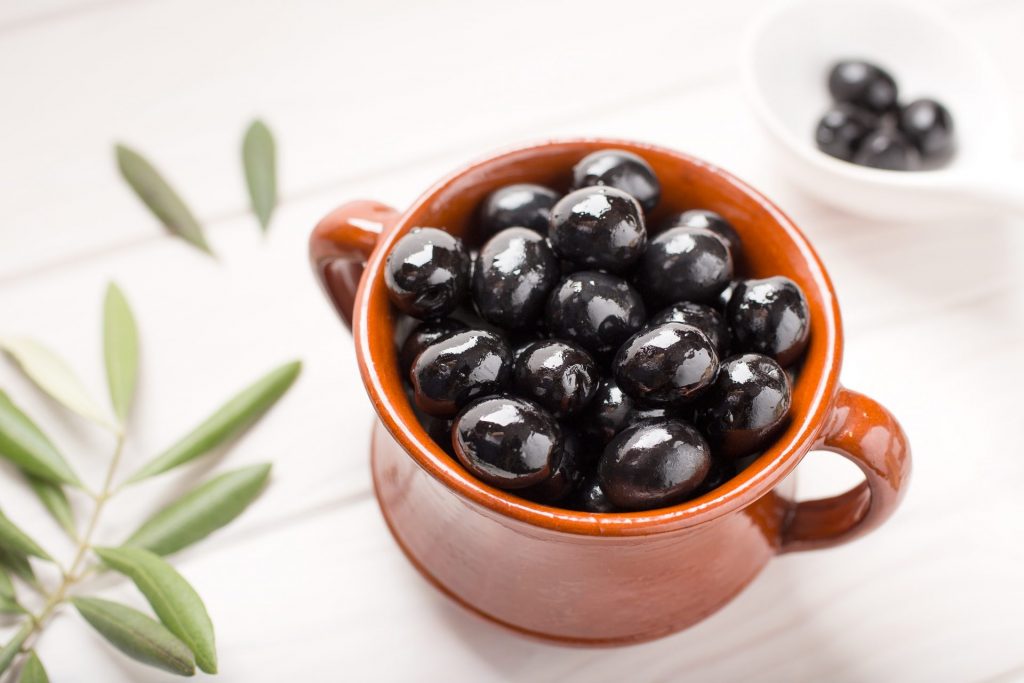
Kalamata Olives for Charcuterie Board
Ah, the legendary Kalamata olives, an undeniable gem in the world of charcuterie boards. These olives, originating from the sunny shores of Greece, bring a touch of Mediterranean magic to your gastronomic adventure.
With their deep purple hue and rich, briny flavor, Kalamata olives stand out as a true delicacy. They possess a unique blend of fruity sweetness and tanginess, making them a must-have addition to any charcuterie board seeking an extra layer of complexity.
When it comes to the overall charcuterie board experience, Kalamata olives contribute their distinct personality. They add a burst of bold flavor, enticing your taste buds with their unmistakable richness. The firm texture of these olives provides a satisfying bite, allowing you to savor their essence alongside other charcuterie delights.
To make the most of Kalamata olives on your charcuterie board, consider their perfect companions. Pair them with creamy cheeses like feta or goat cheese for a harmonious blend of flavors. The creamy, tangy notes of the cheese beautifully balance the robustness of the olives, creating a delectable contrast.
For a delightful Mediterranean-inspired combination, layer Kalamata olives alongside sun-dried tomatoes, thinly sliced cured meats, and a drizzle of extra virgin olive oil. The interplay of flavors takes you on a culinary journey, reminiscent of sun-soaked Mediterranean landscapes and the pleasures of al fresco dining.
Don't be afraid to experiment with different combinations to find your personal favorite. Perhaps you'll discover that Kalamata olives complement the slight saltiness of aged prosciutto, or that they pair exquisitely with roasted red peppers and a sprinkle of fresh herbs.
So, when curating your charcuterie board masterpiece, don't forget to invite the esteemed Kalamata olives to the party. With their rich flavor, captivating appearance, and undeniable allure, these olives will elevate your culinary experience to new heights of taste and sophistication.

Castelvetrano Olives for Charcuterie Board
Prepare to be captivated by the vibrant and delightful Castelvetrano olives. With their unique characteristics and distinct green hue, these olives bring a burst of freshness and a touch of elegance to your charcuterie board.
Castelvetrano olives, hailing from Sicily, Italy, are known for their vibrant green color, reminiscent of lush Mediterranean landscapes. Their mild and buttery flavor profile sets them apart, offering a delightful contrast to the savory and cured elements on your charcuterie board.
These olives have gained popularity in recent years, and for good reason. Their mildness appeals to a wide range of palates, making them an excellent choice for those who prefer a more subtle olive experience. Whether you're a seasoned olive enthusiast or just starting to explore the world of charcuterie boards, Castelvetrano olives are sure to impress.
Pairing suggestions abound when it comes to Castelvetrano olives. Their gentle flavor complements an array of ingredients. Combine them with creamy cheeses such as fresh mozzarella or burrata for a luscious and indulgent treat. Add a sprinkle of fresh herbs like basil or thyme to enhance the aromatic experience.
For a delightful burst of flavor, accompany Castelvetrano olives with citrus segments like orange or grapefruit. The citrusy brightness adds a refreshing twist that perfectly balances the richness of the olives and other charcuterie components.
Incorporating Castelvetrano olives into your charcuterie board not only offers a visual pop of color but also introduces a flavor profile that is both approachable and sophisticated. Their mild and buttery nature makes them a crowd-pleaser, while their vibrant green hue creates an eye-catching visual element.
As you curate your charcuterie board, don't forget to invite the Castelvetrano olives to the ensemble. Their fresh, vibrant, and buttery presence will elevate your culinary creation to new heights, leaving your guests in awe of the delightful harmony of flavors and colors.

Pairing Olives on Charcuterie Boards
In this section we explore some of the best pairings for olives on charcuterie boards, from cheese to wine we will explain the best matches made in heaven.
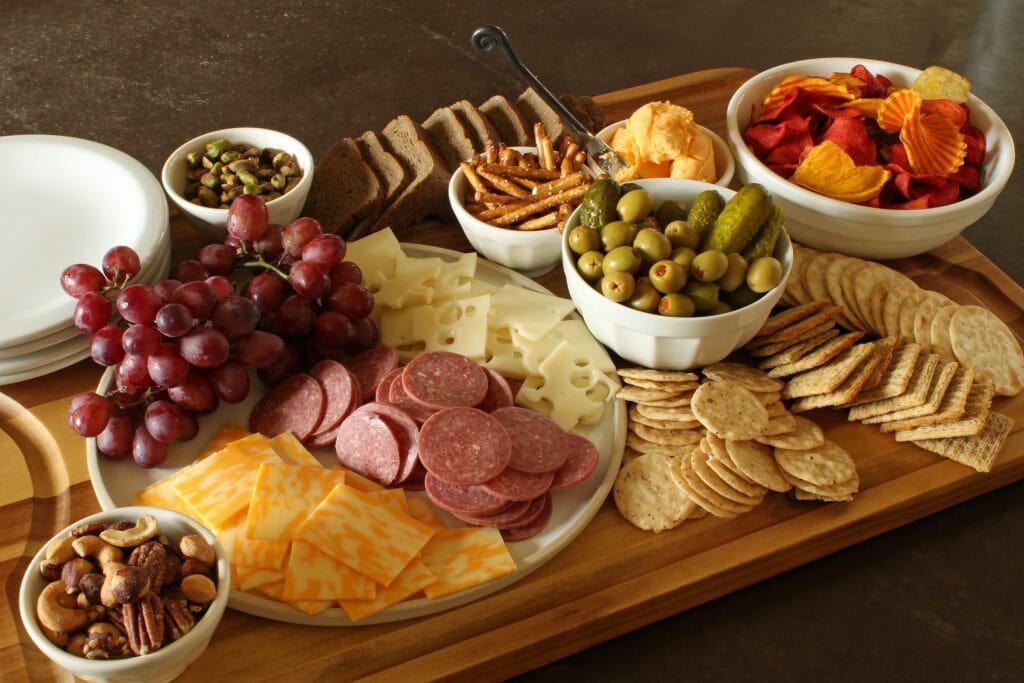
Cheese and Olives for Charcuterie Board
Aged Gouda and Green Olives: A Classic Harmony
Prepare to indulge in the classic pairing of aged Gouda and green olives. The nutty and slightly sweet notes of the Gouda beautifully balance the briny and tangy flavors of the green olives. Together, they create a harmonious combination that delights the palate.
Brie or Camembert with Castelvetrano Olives: Creamy Luxury
Indulge in the velvety goodness of brie or camembert alongside the buttery and mild Castelvetrano olives. The soft and creamy texture of the cheese complements the subtle flavors of the olives, resulting in a luxurious and delightful pairing that melts in your mouth.
Feta Cheese and Kalamata Olives: Mediterranean Delight
Transport yourself to the Mediterranean with the delightful pairing of feta cheese and Kalamata olives. The crumbly and tangy feta cheese finds its perfect match in the intense and fruity flavors of the Kalamata olives. Together, they create a taste sensation that evokes the sun-drenched Greek landscapes.
Explore and Discover Your Favorites
The world of cheese and olives is vast, and the possibilities for pairing are endless. Don't be afraid to experiment with different cheese types, from creamy blues to sharp cheddars, and find the olives that bring out their best qualities. Add a variety of textures, colors, and flavors to create a dynamic and visually appealing charcuterie board that leaves a lasting impression.
Remember, the key to successful cheese and olive pairings is to let your taste buds guide you. Have fun exploring different combinations and discovering your personal favorites. With the right pairing, cheese and olives elevate each other, creating a symphony of flavors that enhances your charcuterie board experience.
Wine Pairing with Olives for Charcuterie Board

The delightful combination of olives and wine can elevate your charcuterie board to new heights. The flavors of the olives interact harmoniously with the nuances of different wines, creating a sensory experience that tantalizes the taste buds. Here's a guide to help you select the right wines to accompany olives on your charcuterie board.
Light and Crisp Whites with Green Olives
When pairing green olives, opt for light and crisp white wines. Sauvignon Blanc, Pinot Grigio, or Albariño are excellent choices. Their citrusy and refreshing profiles complement the briny and tangy notes of green olives, creating a delightful contrast on the palate.
Rosé for Versatility
Rosé wines are incredibly versatile and pair well with a variety of olives. Their fruit-forward and floral characteristics make them a fantastic match for both green and black olives. From Provence rosés to Spanish Garnacha rosados, explore different styles to find your preferred combination.
Red Wine and Black Olives
For the deep, rich flavors of black olives, red wines are an excellent choice. Opt for medium-bodied reds like Merlot, Tempranillo, or Chianti. These wines bring out the earthy and savory qualities of black olives, creating a delicious union of flavors on your charcuterie board.
Sparkling Wine and Olive Medley
For a touch of elegance and effervescence, consider pairing an olive medley with sparkling wine. The crisp acidity and delicate bubbles of Champagne, Prosecco, or Cava complement the diverse flavors and textures of mixed olives, enhancing the overall tasting experience.
Remember, the art of wine and olive pairing is subjective, and personal preferences play a significant role. Feel free to experiment and discover your own unique combinations. Consider the intensity, flavors, and characteristics of both the olives and the wines to create a harmonious balance on your charcuterie board.
Complementary Ingredients for Olives on a Charcuterie Board
While olives are undoubtedly the star of the show on a charcuterie board, incorporating complementary ingredients can take the flavor experience to the next level. Here are some suggestions to enhance your charcuterie board with additional ingredients that pair perfectly with olives.
Cured Meats
Cured meats are a classic choice to accompany olives on a charcuterie board. Their savory and salty flavors create a delightful contrast to the brininess of the olives. Consider adding slices of prosciutto, salami, or chorizo to your board. The rich, fatty notes of these meats beautifully complement the tangy and robust profiles of olives.
Crackers and Bread
Crackers and bread provide a delightful textural element to your charcuterie board. Choose a variety of options, such as crispy baguette slices, artisanal crackers, or crunchy breadsticks. These accompaniments serve as the perfect vessels for enjoying the olives and other components of your board. Experiment with different types and flavors to add depth to your tasting experience.
Spreads and Dips
Introducing spreads and dips can add a layer of complexity and creaminess to your charcuterie board. Consider including options like hummus, tapenade, or roasted red pepper dip. These flavorful spreads provide a fantastic base for combining with olives, creating unique taste combinations that will surprise and delight your guests.
Fresh Fruits
Fresh fruits provide a refreshing and vibrant contrast to the rich flavors of olives. Add slices of juicy melons, ripe figs, or sweet grapes to your charcuterie board. The natural sweetness of the fruits complements the savory notes of the olives, creating a harmonious balance of flavors.
Nuts
Nuts add a delightful crunch and nuttiness to your charcuterie board. Consider including a variety of options such as almonds, walnuts, or pistachios. Their earthy flavors and textures provide a lovely counterpoint to the briny and robust nature of olives.
Remember, the key to creating a well-balanced charcuterie board is to offer a variety of flavors, textures, and colors. By combining olives with cured meats, crackers, bread, spreads, fresh fruits, and nuts, you'll create a sensory experience that will satisfy and impress your guests.
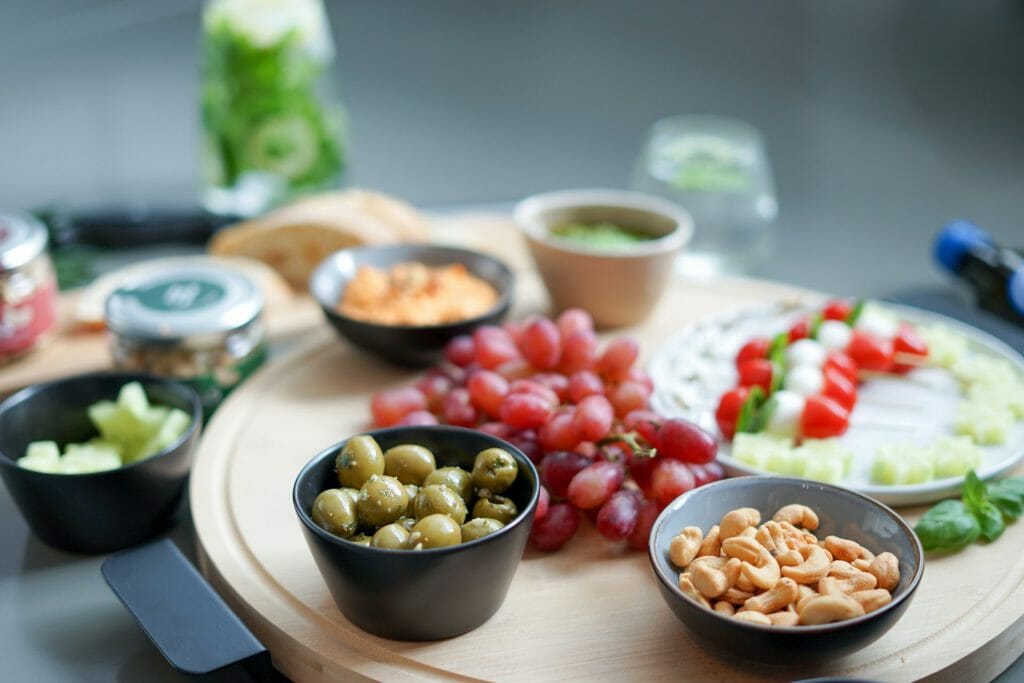
Arranging and Presenting Olives on Charcuterie Boards
How to Arrange Olives on a Charcuterie Board
Creating an appealing presentation is just as important as selecting the right olives for your charcuterie board. Here are some practical tips and artistic approaches to arrange olives in a visually pleasing way.
Variety and Balance
Incorporating a variety of olive colors, shapes, and sizes adds visual interest to your charcuterie board. Mix and match different olive varieties, such as green, black, Kalamata, and Castelvetrano, to create a vibrant display. Aim for a balanced distribution of olives throughout the board, ensuring that each section offers a diverse selection.
Grouping and Clusters
Consider grouping olives together to create clusters. This technique not only enhances the visual appeal but also makes it easier for your guests to select their preferred olives. Arrange olives in small piles or lines, alternating between different types for an enticing presentation.
Integrate with Other Ingredients
Integrate olives with other ingredients on your charcuterie board to enhance the overall aesthetic. Place olives alongside cured meats, cheeses, and fresh fruits to create a cohesive and visually appealing arrangement. The vibrant colors and unique shapes of olives can complement the textures and colors of other components, creating an eye-catching display.
Artistic Touches
Add an artistic touch to your olive arrangement by incorporating decorative elements. Sprinkle fresh herbs like rosemary or thyme around the olives for a natural and aromatic touch. Use small bowls or ramekins to hold olives, creating a focal point within the overall arrangement. Additionally, consider using charcuterie boards of different shapes and sizes to add dimension and visual interest.
Remember, the arrangement of olives on your charcuterie board should not only be visually appealing but also practical for serving and enjoying. Consider the size and accessibility of olives to ensure ease of serving and a delightful tasting experience for your guests.
Olives as Garnish for Charcuterie Board
When it comes to creating a visually stunning charcuterie board, olives can play a delightful role as decorative elements and garnishes. Not only do they add a pop of color, but they also contribute to the overall aesthetic appeal of the board. Let's explore some creative ideas for using olives as garnishes and accents.
Olive Skewers
One simple and elegant way to incorporate olives as garnishes is by threading them onto skewers. You can combine olives with other ingredients like cherry tomatoes, cheese cubes, or even small pieces of cured meat to create visually appealing skewers. These skewers can be strategically placed throughout the charcuterie board, adding height and interest to the arrangement.
Olive Rosettes
Another creative idea is to create olive rosettes. Start by slicing olives lengthwise into thin strips. Take one strip and roll it tightly to form a rosette shape. You can create multiple rosettes and scatter them across the board to add a touch of elegance and sophistication. These olive rosettes can be placed alongside cured meats, cheeses, or other complementary ingredients.
Olive Sprinkles
For a more subtle yet effective garnishing technique, consider using chopped or finely diced olives as sprinkles. Sprinkle them over the cheeses, meats, or even on dips and spreads. The vibrant colors and unique texture of the olives will add visual interest and draw attention to different elements on the charcuterie board.
Olive Leaf Accents
Don't forget about the leaves! Olive leaves can be used as decorative accents to further enhance the overall visual appeal of your charcuterie board. Look for fresh olive leaves or even artificial ones if fresh ones are not available. Place them strategically around the board, tucking them underneath the ingredients to create a natural and rustic touch.
By incorporating olives as garnishes and accents, you not only add visual appeal but also highlight their significance as a key ingredient. The combination of colors, shapes, and textures on the charcuterie board creates an inviting and appetizing display for your guests.
Olive Bowls for Charcuterie Board
When it comes to serving olives on a charcuterie board, you may consider adding a touch of elegance and convenience by incorporating specialized olive bowls. These small bowls specifically designed for olives can enhance the overall presentation and make it easier for guests to enjoy their favorite olive varieties. Let's delve into the availability, purpose, and tips for using olive bowls on your charcuterie board.
Availability and Purpose
Specialized olive bowls can be found in various materials, such as ceramic, glass, or even wood. They are typically designed with compartments or sections to hold different types of olives, allowing you to showcase a variety of flavors and textures. Olive bowls serve a dual purpose of keeping olives organized and preventing them from rolling or spreading their juices onto other ingredients on the board. This containment helps maintain the integrity of the overall presentation.
Elegance and Convenience
By using olive bowls, you add a touch of sophistication and refinement to your charcuterie board. The separate compartments or sections make it easy for guests to select their preferred olives without having to navigate through a mixed arrangement. This not only enhances the visual appeal but also adds a layer of convenience, ensuring a delightful and hassle-free olive tasting experience for your guests.
Recommendations for Selecting and Incorporating Olive Bowls
When selecting olive bowls, consider the overall theme or style of your charcuterie board. Opt for bowls that complement the aesthetics and colors of the other elements. For instance, if you have a rustic-themed board, wooden olive bowls can add a charming and natural touch. If your board has a more modern or elegant look, ceramic or glass olive bowls can lend a sleek and sophisticated feel.
To incorporate olive bowls on your charcuterie board, strategically place them at different points, dispersing them alongside other ingredients. This ensures that guests can easily access and enjoy the olives without overcrowding a single area. Additionally, consider labeling the olive bowls or providing small serving utensils to encourage engagement and exploration.
Remember, while olive bowls can be a visually appealing addition to your charcuterie board, they are optional. If you don't have specialized olive bowls, you can still showcase olives using other small dishes or compartments on your board.

Health Benefits and Nutritional Value of Olives on Charcuterie Boards
When it comes to the health benefits and nutritional value of olives, these delightful little fruits have a lot to offer. Including olives on your charcuterie board not only adds flavor and visual appeal but also contributes to a balanced and nutritious spread. Let's delve into the nutritional content and health benefits associated with olives.
Nutritional Content
Olives are rich in healthy fats, particularly monounsaturated fats, which have been linked to various health benefits. They also contain essential vitamins and minerals, including vitamin E, iron, and copper. While the exact nutritional profile may vary depending on the olive variety, a typical serving of olives (about 10 medium-sized olives) provides approximately:
- Calories: 50-60
- Fat: 4-6 grams
- Carbohydrates: 2-3 grams
- Fiber: 1-2 grams
- Protein: 0-1 gram
Healthy Fats and Antioxidants
Olives are known for their high content of monounsaturated fats, such as oleic acid. These healthy fats have been associated with reducing the risk of heart disease and inflammation. They can help improve blood cholesterol levels and support overall heart health.
Additionally, olives are a rich source of antioxidants, including phenolic compounds and vitamin E. These antioxidants help protect the body against oxidative stress, which can contribute to chronic diseases and aging. The presence of antioxidants in olives is especially noteworthy, as they play a crucial role in maintaining cellular health and fighting free radicals.
Other Beneficial Properties
Olives also contain other beneficial properties that can positively impact health. For example, they are a natural source of polyphenols, which have been studied for their potential anti-inflammatory and anticancer effects. Olives may also have antimicrobial properties, helping to combat certain harmful bacteria.
Contribution to a Balanced and Nutritious Spread
By including olives on your charcuterie board, you not only enhance the taste and presentation but also boost the nutritional value of the spread. Olives provide a satisfying and flavorful addition that complements the other ingredients. Their healthy fats and antioxidants can help create a more well-rounded and nourishing experience.
However, it's important to keep portion sizes in mind, as olives are relatively high in calories. Moderation is key to enjoying the health benefits without overindulging.
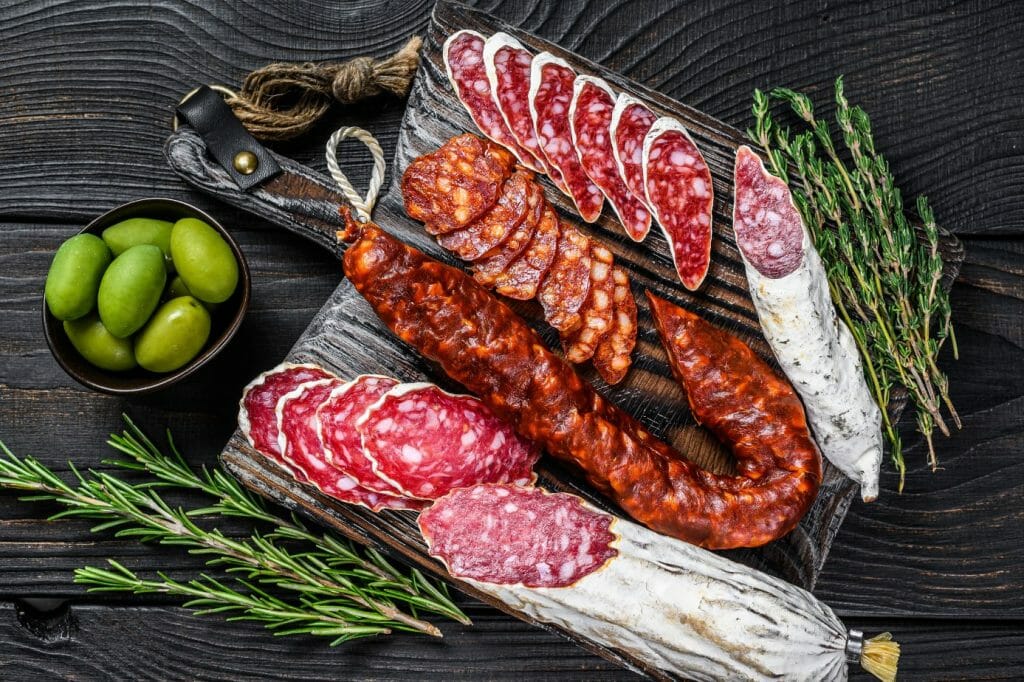
Wrapping It Up
In conclusion, olives play a crucial role in creating a memorable and delightful charcuterie board experience. We have explored the versatility and numerous options available, from the tangy green olives to the rich and earthy Kalamata olives, and the mild and buttery Castelvetrano olives. Each variety brings its own unique flavors and characteristics to the table.
By carefully selecting olives and pairing them with complementary ingredients such as cheeses, cured meats, crackers, bread, and spreads, you can create a harmonious symphony of flavors that tantalize your taste buds. The interplay between olives and these accompaniments enhances the overall taste and texture of your charcuterie board, taking it from ordinary to extraordinary.
Don't be afraid to experiment and try different combinations. The world of olives is vast, and there are endless possibilities waiting to be discovered. Perhaps you'll find that the briny green olives perfectly complement a creamy goat cheese, or that the robust black olives pair exquisitely with a sharp cheddar. Let your taste buds guide you and embark on a journey of culinary exploration.
Remember, presentation is key.
Take the time to arrange your olives thoughtfully, considering both aesthetics and functionality. Whether you choose to scatter them across the board or place them in a beautiful olive bowl, their presence will add elegance and charm to the overall display.
As you savor each bite of your carefully curated charcuterie board, featuring the finest olives and complementary ingredients, you'll experience a satisfying blend of flavors and textures. The marriage of olives, cheeses, cured meats, and other delectable elements will leave a lasting impression on both your palate and your guests.
So, the next time you prepare a charcuterie board, be sure to include a variety of olives. Explore the different flavors and textures they offer, and let your creativity shine. Discover your personal favorites and create a sensory experience that will be cherished by all who partake.
Bon appétit!
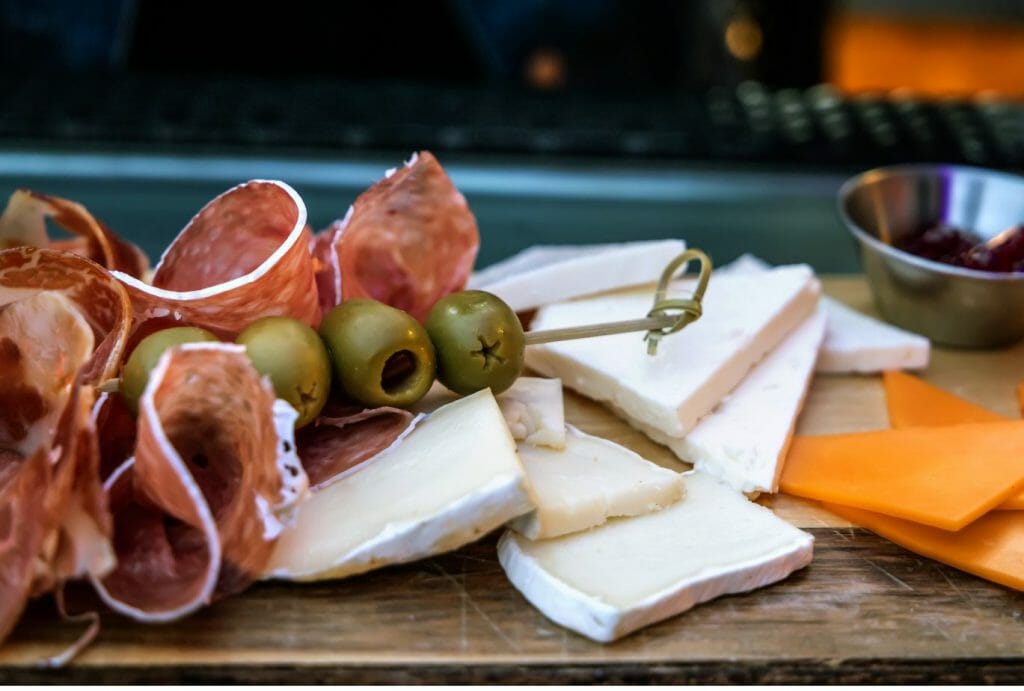
Frequently Asked Questions
What kind of olives go on a charcuterie board?
The ideal olives for a charcuterie board include a variety of options such as green olives, black olives, Kalamata olives, and Castelvetrano olives. These olives offer different flavors and textures that complement the other ingredients on the board. Green olives have a tangy and slightly bitter taste, while black olives tend to be milder. Kalamata olives add a rich and briny flavor, and Castelvetrano olives provide a buttery and sweet taste. Ultimately, the choice of olives depends on personal preferences and the desired flavor profile of the charcuterie board.
Do you put olives on a charcuterie board?
Yes, olives are a common and delicious addition to a charcuterie board. They provide a burst of flavor and add a savory element to the assortment of cured meats, cheeses, and other accompaniments. Olives offer a variety of tastes and textures, allowing you to create a diverse and well-rounded charcuterie board experience. Whether you prefer green, black, Kalamata, or Castelvetrano olives, their presence on a charcuterie board enhances the overall enjoyment and adds a touch of Mediterranean flair.
How do you serve olives on charcuterie board?
To serve olives on a charcuterie board, you can arrange them in small bowls or directly on the board itself. Place the olives strategically around the other ingredients to ensure easy access for your guests. Consider using different varieties of olives to provide visual interest and offer a range of flavors. You can also incorporate olive branches or leaves as decorative elements. Remember to provide small forks or toothpicks for guests to easily pick up the olives.
How many olives per person on charcuterie board?
The number of olives per person on a charcuterie board can vary depending on personal preferences and the overall size of the board. As a general guideline, you can allocate 4-6 olives per person. This allows for a satisfying portion without overpowering the other elements on the board. However, feel free to adjust the quantity based on the number of guests and their love for olives. It's always a good idea to have a variety of olives to cater to different tastes.
Share Your Creations:
We’d love to see the charcuterie boards you create using our guide! Feel free to share your own creations in the comments or on social media, and tag us for a chance to be featured. And if you have any other ideas or tips for creating the perfect charcuterie board, we’d love to hear them.

